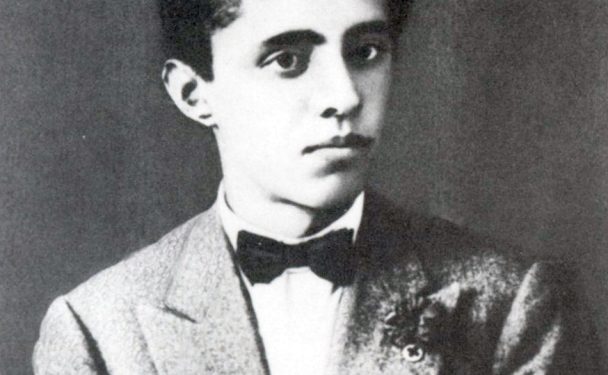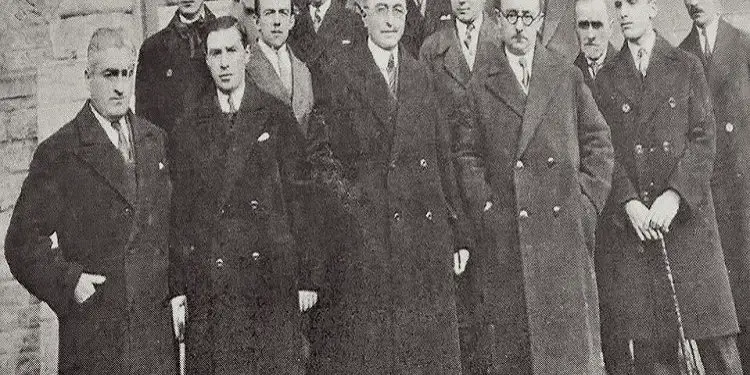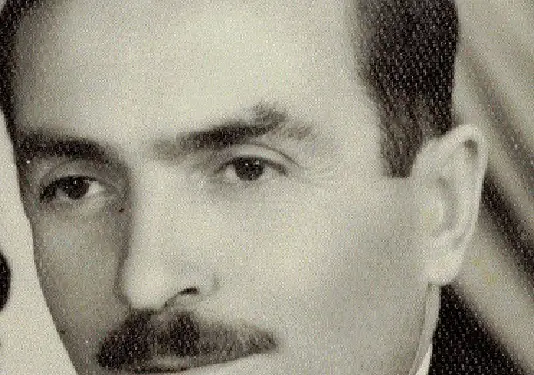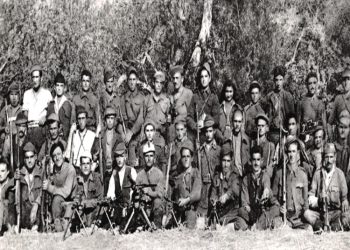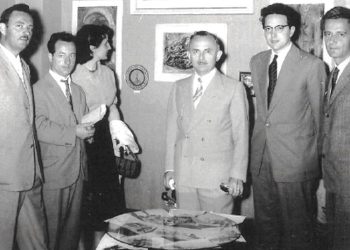From Pellumb Çuni
Memorie.al / The former high school students of the French Lyceum of Korça have become rare and now only their memories remain. Part of them had Enver Hoxha as a colleague in studies and part as a teacher. Lefter Pepo was one of the lyceum students. He keeps memories of those years, when you had Enver as your teacher. Lefter has collected materials that belong to the 22-year life of the French high school. For Pepo, Enver Hoxha remained his professor and he remained his student.
Mr. Pepo, how do you remember Enver Hoxha, as one of your teachers?
To get to Enveri, we will talk a little at the beginning about the history of the Liceu. Enveri had been a student of this Lyceum and later came as a professor.
You are busy with the collection of documents that talk about the life of the Lyceum. Can you tell us something?
The Lyceum was opened on October 25, 1917. It was supported by Themistokli Gërmenji. As the first professor of the French language, a former officer named Dequan remained. The officer, as he left 640 soldiers killed in the war, took off his military clothes and put on those of the professor. All subjects were taught in French, only the Albanian language, it was in Albanian. The demands have been high.
1500 students were registered and only 246 of them finished. Some of the former students became professors after finishing higher studies in France. The level of knowledge was the same as that of peers in France. Those who followed the high finished it successfully, and because they were asked to stay outside, they came back to their hometown.
Can you mention some names of former students who became professors at the Lyceum?
Yes, I can say some of them. There are 20 high school students who became teachers. We are mentioning Gjergji Canco, Petraq Pepo, Kristaq Fundo, Petraq Fundo, Selman Riza, Nonda Bulka, Enver Hoxha, Abaz Ermenji, Raqi Qirinxhi, Sotir Kuneshka, etc. From the Pepo tribe, 9 boys graduated from the French High School, 6 of them graduated from high school in France and Italy.
What about the first Albanian teachers?
The first Albanian teachers, who started teaching at the High School, alongside the former soldier Dekuan (Dekoing), were: Thoma Avrami, Llambi Gërmenji, Haki Mborja, Gaqo Geço, Nikuca Ballamaçi.
Who secured the high school building?
Tradition was not lacking in Korça. Dimanti Tërpo, donated the house for the first Albanian teacher. In the beginning, the Lyceum was opened in the house of Nuçi Mborje. For two years, teaching took place here. In the beginning there were two classes, but seeing that the number of students was increasing, then the Military Hospital was vacated until 1938, when Thoma Turtulli, donated the new building for the Lyceum, which today is the Military Infantry Brigade.
For the first time, French started in Korça, in 1917?
The Korcarians had known the French language years ago. Mihal Turtulli graduated as a doctor in 1856, in 1878, Theodhir Gjini for literature, Thoma Orollogai for law in 1888, Mihal Lako for literature in 1892, etc. So the Korcars were familiar with this language. The Lyceum served to fill a gap of those years, with fully educated staff of the time. During the 22 years, 5 French directors and 14 professors have been noted.
There were 32 Albanian teachers, 20 of whom had graduated from the Lyceum there. Many well-known names emerged from the Liceu, such as: Enver Hoxha, Ymer Dishnica, Medar Shtylla, Koço Theodhosi, Behar Shtylla. Mahir Domi, Dhimitër Shuteriqi, Ptolem Xhuvani, Bilbil Klosi, Kolë Paparisto, Stefanaq Pollo, Llambi Ziçishti, etc. The high school prepared high-level students, some of whom became engineers, economists, doctors, etc.
What about the best high school students, who were they?
It was not Enver Hoxha, among the most distinguished. Two former students from Korça, Sotir Kuneshka and Raqi Qirinxhi, who graduated in mathematics and became teachers at the High School, were awarded the highest marks for all the years. Raqi Qirinxhi, professor of mathematics, joined Lufta. He was the intendant of the Korca District Headquarters. Lost in January 1944.
The murder and disappearance of the partisan professor remained a mystery!? Lyceum student Guri Stratobërda and Teli Samsuri are also witnesses. Lyceum was a very demanding school. There was no question of whose son or daughter you were. 1500 students were registered to follow it and only 246 completed it. Without work and study, you remained in class.
The Liceu only dealt with lessons, so apart from the theoretical side, was there teaching practice, or other activities, such as cultural and artistic?
The lyceum, in addition to French-level knowledge, cultivated cultural and sports activities. It had its own choir that gave concerts with songs and humor. It had its own orchestra. It gave space to talents. We mention the pianist, Boris Plumbi, who learned the piano at the Lyceum and became one of the greatest pianists in the country, after studying this musical instrument.
Among the old Korçars, we remember high school student Teli Samsuri, who played football with the team of “Vllazerim”, today’s “Skënderbeu”, the only major trophy won by Korçar football in years. In 1933, he became the champion of the country and Teli Samsuri scored the winning goal against Tirana. Teli turned out to be a partisan and was shot by the Germans in the Thessaloniki camp.
Do you remember the first day of school?
When I put on the cap with the red and black ribbon, I certainly felt the excitement as the first day of school began. We had a gray uniform in light suits, with white shirts in the summer. They didn’t accept you without a uniform. There were strict rules. The day you were absent, your father or another family member would come to inform them that they would not let you into class the next day. The lesson was 60 minutes with a 5-minute break between them, when we changed the books. There were no students hanging out in the corridors or in the windows, like today’s high school students do.
But do you remember anything else, from the strong rule of the French school?
I remember a lesson. As it began, a swallow was circling to build its nest in the eaves of the building. I just played a little, to see, and didn’t stand up when the professor entered the classroom. The mathematics professor kept me at the blackboard for the whole hour, where I solved problems and exercises. He gives, and I choose.
He didn’t yell at me, he didn’t even scream. He didn’t tell me why he was punishing me in this way, so that I could understand for myself why I was being punished and tell my friends why I spent the hour standing in front of the blackboard. There was no noise in the classroom. Students worked independently. We did not copy from our friends, and if you were caught copying, the punishment was severe.
And Enver Hoxha, what subject did he teach them?
Enver gave me the subject of morality. It was an easy subject, but Enveri made it easier for us because he communicated well with us. I remember that during class, Enveri never sat at the professor’s desk. He sat in the first benches of the class. He changed these banks every lesson. The literature he gave us was related to the moral education of high school students. Enver communicated well.
He didn’t see the diary, he left it on the table where he was supposed to sit, but he didn’t stay there for an hour. He longed not to be different from the upper strata of the corcar, but at the same time he mixed with the lower strata of the corcar society. With the Korchar proletariat, he had found a language of understanding. Even in the Lyceum, there was a revolutionary core operating in secret.
How many years did Enver teach?
He gave me 2 years. He came in 1937 and until 1939, when the invading Italians arrived, the Lyceum was closed. The French professors left. Our people were preparing a part for the War. Enver never raised his voice, but with a sweet smile, he warmed the class. He never got excited about teaching. He didn’t shout at us. There were 31 of us in the class. Of these, ten were girls. In April 1939, the fascist invasion was met with protests in Korça, where the professors led the high school students and the people.
The national flag was carried by Abaz Ermenji. This fact must be said, despite the fact that he later took a different path, from that of Enver Hoxha. The lyceum was not opened in September 1939, so it also marks its closure, after the departure of the French professors. In 1945, it was reopened, but Serbo-Croatian was introduced as the language, and later Russian. The lyceum as a continuation today is the “Raqi Qirinxhi” gymnasium, as a former student and mathematics professor and “Martyr of the Fatherland”.
Did the girls live alone?
Yes, the girls sat in the first benches and the boys behind them.
Did Enveri hang out in the banks where the girls hung out?
I told you that he stayed in the first benches and changed them every lesson. The bench where he sat emptied.
How do you remember his portrait in those years?
He was a beautiful, pleasant and charming boy. He used to wear good suits. He lived a civic life. Enver Hoxha taught for two years at the Lyceum. One year in the building where he had been a student and one year in the new building, which was built and built by Thoma Turtulli. He spoke French fluently without interruption. It seemed to us that he was reciting. He was a poet of morality, while Raqi Qirinxhi was a poet of mathematics.
As a former student of Enver, how were your relations after the liberation?
I have met him several times. When he divided the tapis in Krutje in Lushnje, I was in the Agrarian Reform commission. In honor of his arrival, a lunch was served. As a former student, he motioned for me to come over, because he recognized me. He had a remarkable memory. “I will not stop the reforms, Lefter! The power now belongs to the people” – he told me.
What about other times?
In 1955, the Tourism Company was opened in Korça. I was an account manager. Enver Hoxha also came and participated. We met again; where he asked me about the work in Korça and told me that; the perspectives are clear, to take more giant steps. During the winter holidays, from 1955 to 1972, Enveri came to Korça and spent them there. During these vacations, I have never been absent from the meetings he has had with the staff of Korça.
He treated me like a former student of his. And for me, he remained my professor. When he returned from a walk or work meetings, which he often did, he came to the Tourism salon to drink coffee. We sat together and talked about Korça. He asked me about all the acquaintances from the city of Korça. From the professor’s features, the smile remained. As a leader now, he even raised his voice, in high tones. He remained an admirer of the city of Korça.
How many of the former lyceum students are still alive?
They are with grains now and are being shipped daily. Boris Plumbi is gone. We are dying and the last ones. Dhimitër Fallo lives in Voskopoja, the others are in Korça and Tirana.
Echoes in the press of the time of the French Lyceum of Korça
On the occasion of the 20th anniversary of the Lyceum “Gazeta e Korça”, wrote: “The director was the French Mr. Vital Gerson and professors, Mr. Mihal Bellkameni (vice director), Vasil Qiriako and Dhimitër Gjeorgjiadhi. In the first year 1917-1918, the Lyceum had only 36 students. In the second year, Franco-Albanian was filled with new professors, such as K. Xega, N. Ballamaçi, etc. In this way it continued for three years, having 50 students each. The Greek gymnasium, which for some time no longer worked properly, was finally closed in 1918”. (Korça newspaper, October 1937). The last generation that finished high school with French professors were: Xhuvi Bino, Stefanaq Pollo, Zija Xholi, Fatmir Gjata, Boris Plumbi, Llambi Zicishti, Thoma Harilla, etc.
Personalities who studied at the Lyceum
Petraq Pepo: He was born in Korça in 1903. When he was 14 years old, he enrolled in the French Lyceum. He was one of the 36 students who started the Lyceum and one of the 9 students who were able to reach the eighth grade in 1925. He finished at the Sorbonne and returned in 1930 to Korça, to the Korça Lyceum, now as a professor, where gives the subjects; History, Geography and Ancient Greek.
In October 1940, he was arrested and imprisoned in Bari, Italy. After the liberation of the country, he was appointed to the Higher Pedagogical Institute in Tirana, where he prepared the country’s army of young teachers. In 1946, when the Peace Conference was held in Paris, the Albanian delegation included Petraq Pepo as a consultant.
Petraq Pilika: With the creation of the University of Tirana, he was appointed the head of the Mathematics department and the creation of the Academy of Sciences in 1973, also a member of it.
Fahredin Angoni: Former lyceum student Fahredin Angoni was shot on June 6, 1945, with five other friends, in the place called “Chestnuts of Zërvaska” in the district of Pogradec. 28 people appeared in court, on this date, where 14 people were sentenced by shooting. The chairman of the trial was Irakli Bozo, a schoolmate of Fehredin. Fahredin Angoni was born on January 18, 1908 in the city of Gjirokastra. He was one age with Enver Hoxha, but during the War, he did not follow him like other high school students.
He was ingratiated with the nationalist youth. In 1924, he came to Korçë where he started the French high school and graduated in 1933. For family reasons, he did not study in France, but worked as a teacher in the villages of Korçë, where he taught in Pojan and Progër. Since he was a lyceum student, he translated “The Barber of Seville”, “The Genius Boy (Moxarti)” from French. Translated from the German “Faustin” by Goethe. These translations were published in the printing house “Dhori Koti”, in the city of Korça.
Professorship
In the French Lyceum of Korça, Albanian professors were: Nonda Bulka, Vangjush Mio, Stavro Skëndi, Foto Bala, Vedat Kokona, Raqi Qirinxhi, Selman Riza, Enver Hoxha, Abaz Ermenji. By the end of World War II, the lyceum students heard would be sent to the city of Korça; Tomorr Zavalani, Viktor Emanueli, Ali Qemali, Petraq Ximetiku, Drini Panariti. They settled in America, where in 1950, another high school student arrives, who escapes from prison in a spectacular way. He, after shooting the policeman paralyzing him, puts on his uniform and crosses the prison, and later the border, is thrown into Greece, and from there ends up in America. They ran away, but the change was then taken away by their relatives.
The school that produced the head of the Albanian state after the Second World War
Former lyceum students
1500 were enrolled in the Lyceum and 246 graduated. Of the lyceum students who finished their studies, 129 were Korcars, 96 of them graduated from high school in France. The other 117 were from other districts and from Kosovo. The French Lyceum was a high school in the French language and in 1922, it was named the National Lyceum. The first group ended in 1926. The first group lasted 8 years, then the other groups lasted 9 years each. During the 22 years of its existence, from 1917 to 1939, two korchars, Sotir Kuneshka and Raqi Qirinxhi, received the maximum evaluation. Memorie.al




